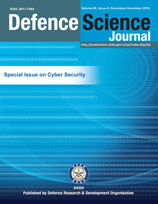Comparison of 3D Versus 4D Path Planning for Unmanned Aerial Vehicles
DOI:
https://doi.org/10.14429/dsj.66.9575Keywords:
Unmanned aerial vehicles, UAV, path planning, modelling, simulation, 3D path planning, 4D path planningAbstract
This research compares 3D versus 4D (three spatial dimensions and the time dimension) multi-objective and multi-criteria path-planning for unmanned aerial vehicles in complex dynamic environments. In this study, we empirically analyse the performances of 3D and 4D path planning approaches. Using the empirical data, we show that the 4D approach is superior over the 3D approach especially in complex dynamic environments. The research model consisting of flight objectives and criteria is developed based on interviews with an experienced military UAV pilot and mission planner to establish realism and relevancy in unmanned aerial vehicle flight planning. Furthermore, this study incorporates one of the most comprehensive set of criteria identified during our literature search. The simulation results clearly show that the 4D path planning approach is able to provide solutions in complex dynamic environments in which the 3D approach could not find a solution.
Downloads
Published
How to Cite
Issue
Section
License
 Where otherwise noted, the Articles on this site are licensed under Creative Commons License: CC Attribution-Noncommercial-No Derivative Works 2.5 India
Where otherwise noted, the Articles on this site are licensed under Creative Commons License: CC Attribution-Noncommercial-No Derivative Works 2.5 India


